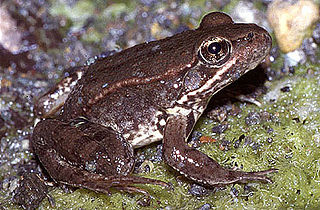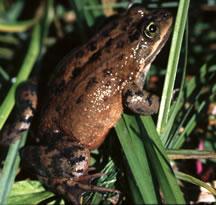
The common frog or grass frog, also known as the European common frog, European common brown frog, European grass frog, European Holarctic true frog, European pond frog or European brown frog, is a semi-aquatic amphibian of the family Ranidae, found throughout much of Europe as far north as Scandinavia and as far east as the Urals, except for most of the Iberian Peninsula, southern Italy, and the southern Balkans. The farthest west it can be found is Ireland. It is also found in Asia, and eastward to Japan. The nominative, and most common, subspecies Rana temporaria temporaria is a largely terrestrial frog native to Europe. It is distributed throughout northern Europe and can be found in Ireland, the Isle of Lewis and as far east as Japan.

Rana is a genus of frogs commonly known as the Holarctic true frogs, pond frogs or brown frogs. Members of this genus are found through much of Eurasia and western North America. Many other genera were formerly included here. These true frogs are usually largish species characterized by their slim waists and wrinkled skin; many have thin ridges running along their backs, but they generally lack "warts" as in typical toads. They are excellent jumpers due to their long, slender legs. The typical webbing found on their hind feet allows for easy movement through water. Coloration is mostly greens and browns above, with darker and yellowish spots.

The California red-legged frog is a species of frog found in California (USA) and northern Baja California (Mexico). It was formerly considered a subspecies of the northern red-legged frog. The frog is an IUCN near-threatened species as of 2021, has a NatureServe conservation status of Imperiled as of 2015, and is a federally listed threatened species of the United States that is protected by law.

The banded bullfrog is a species of frog in the narrow-mouthed frog family Microhylidae. Native to Southeast Asia, it is also known as the Asian painted frog, digging frog, Malaysian bullfrog, common Asian frog, and painted balloon frog. In the pet trade, it is sometimes called the chubby frog. Adults measure 5.4 to 7.5 cm and have a dark brown back with stripes that vary from copper-brown to salmon pink.

The Rio Grande leopard frog is a species of aquatic frog native to the southern United States in Texas and New Mexico, and south through Mexico and Central America. It is also sometimes referred to as the Mexican leopard frog. The epithet berlandieri is in honor of the naturalist Jean Louis Berlandier, who worked for the Mexican government on one of the first biological surveys of Texas.

Indosylvirana aurantiaca, commonly known as the golden frog, is a species of frog endemic to the Western Ghats of India. The species is also known as the Trivandrum frog, the common wood frog, or the small wood frog.

The Oregon spotted frog is a member of the frog family Ranidae of order Anura. It is a medium-sized aquatic frog endemic to the Pacific Northwest and historically well distributed in the Puget Trough/Willamette Valley province and the Cascade Mountains of south-central Washington and Oregon. It is relatively rare within its range and is listed globally as vulnerable.

Rana longicrus, also known as the Taipa frog or long-legged brown frog, is a species of frog in the family Ranidae. It is distributed to northern and central Taiwan.

The Tago's brown frog or simply Tago frog is a species of frog in the family Ranidae endemic to Japan. It is widely distributed within Japan and found on Honshu, Shikoku, and Kyushu, as well as on some outlying islands. There are two subspecies:

Hylarana tytleri is a frog species in the family Ranidae. It is found in eastern and northeastern India, Myanmar, Bangladesh, and southern Nepal, and possibly at lower elevations in Bhutan. It was formerly placed in Rana, and included in the common green frog. It is probably a close relative of that species nonetheless, and thus placed in the revalidated genus Hylarana, of which H. erythraea is the type species. Common name Theobald's ranid frog has been coined for it, although common names for Indian frogs previously identified as Rana erythraea include yellow-striped frog, leaf frog, and leaping frog.
Boophis haingana is an endangered species of skeleton frog endemic to southeastern Madagascar. It is characterized by its advertisement call, which has shorter note durations and faster note repetitions compared to other frogs in its genus. It is pale green in color and translucent at certain parts of the body, such as the dorsal and ventral skin.
Typhlacontias punctatissimus, also known commonly as the dotted blind dart skink, the speckled burrowing skink, and the speckled western burrowing skink, is a species of lizard in the family Scincidae. The species is native to southern Africa. Three subspecies are recognized.

The Miyako toad is a subspecies of the Asiatic toad that is native to the Miyako Islands, in the Ryūkyū Islands of Japan.

Rana uenoi is a species of true frog that was discovered in 2014 using mtDNA and comparative morphology etc. to distinguish it from its previously designated species, Dybowski's frog. It is found in wooded areas in the Korean Peninsula and the nearby islands. It is also found on Tsushima Island, Japan.
Rana culaiensis, commonly known as the Culai brown frog, is a species of true frog from Mt. Culai in the Shandong Province, China.

Rana dabieshanensis is a species of true frog that was discovered in the Dabie Mountains in Anhui, China through genetic analysis and morphology.
Rana zhijinensis, the Zhijin brown frog, is a species of true frog native to the Guizhou Province, China.












